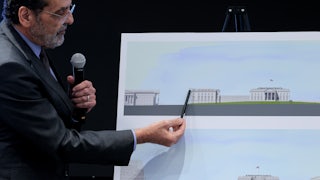Almost from the moment Joe Biden stepped aside in favor of Kamala Harris, the concern trolling commenced. “Harris’s biggest political liability is that she may be seen as too politically extreme,” fretted very serious journalist Josh Barro before advising the new Democratic nominee to “run to the center.” Former Bill Clinton adviser Douglas Schoen concurred, confidently telling CNBC that “the key for her campaign is moving to the center.” To satisfy New York magazine political columnist Jonathan Chait, a mere “pivot” to the center would not be enough. Rather, he provocatively suggested, “Harris needs to adopt positions that will upset progressive activists.”
Apparently, Harris’s nomination didn’t just unite the Democratic base. It also united a parade of pundits, politicos, and conventional wisdom–mongers of all stripes in urging her to unceremoniously betray the base by swerving to the center—especially on the economy—if she’s to have a fighting chance of defeating Donald Trump at the polls.
Given the divisive state of American politics, that might not sound like such an unreasonable take. But glaringly absent from this allegedly centrist consensus is a working definition of what or where the political and economic “center” actually is. And spoiler alert: On most issues, the center is arguably somewhere in the vicinity of Kamala Harris. Especially on the economy.
To understand why, we need to think a little bit about what would comprise a truly “centrist economics.” But before we do that, we need to define our terms.
The whole left-right dichotomy dates back to the early days of the French Revolution, when members of the National Assembly who favored a more revolutionary path (that is, a republic) took to sitting to the left, while those defending the ancien régime (the monarchists) gathered together on the right. Today, we universally put conservatives on the right and progressives on the left. Policies that favor the rich go on the right, policies that favor working people go on the left. An economic ideology that advocates unfettered free market capitalism definitely goes on the right, while a Marxist dictatorship of the proletariat is the sine qua non of far left.
Most people still have a shared intuition about what the political labels “left” and “right” mean, particularly in regard to how competing policy proposals relate to one another. But the “center”? Not so much. For example, most people would instantly agree that a proposal to more than double the federal minimum wage to $15 an hour would fall on the left or even far-left side of the spectrum. After all, it’s more than double!
Yet ask people to pick an ideologically “centrist” minimum wage rate and this remarkable consensus instantly falls apart.
Self-described centrists often pride themselves on reaching across the aisle to negotiate bipartisan compromise. But ideological centrism can’t be as simple as just splitting the difference—in fact, on many noneconomic issues, difference-splitting would be facially absurd. For example, how do we split the difference on marriage equality, or on the peaceful transfer of power? How would we split the difference on Trump’s plan for the “bloody” deportation of 20 million people? Would a centrist alternative be just 10 million deportations, and with precisely half as much blood?
And even on economic issues that can be easily quantified in dollars, difference-splitting can make little sense. Splitting the difference between $15 and $0—that’s the essence of the Project 2025 proposal, which would allow states to opt out of enforcing a minimum wage at all—would set the federal minimum wage at just 25 cents more than the current $7.25-an-hour rate that has been relentlessly eroded away by inflation for the 15 years that have passed since the last increase in the federal minimum wage. That’s not centrism. That’s defending the status quo, a quintessentially conservative instinct that has long been associated with the political right.
The truth is, there is no inherently centrist ideology. According to an analysis by 538, the large plurality of voters who self-identify as moderate are in fact “all over the ideological map.” That’s why if you ask the average person to describe an ideologically centrist policy position, they usually default to the position they already hold.
And in fact, that’s exactly what Barro and Schoen and Chait and others have done in assuming that Harris’s positions are “too politically extreme.” The center to them is where they currently stand—smack dab in the middle of the old neoliberal consensus that had long dominated both parties before Biden abandoned it in favor of an agenda that grows the economy “from the middle out.” And it’s that neoliberal center they want Harris to reclaim.
Neoliberalism argues that markets are inherently efficient, rational, and meritocratic, and that the fastest path toward achieving the greatest good for the greatest number of people is to simply get out of the market’s way. Over the nearly half-century during which neoliberalism held sway, the ideologically centrist agenda was dominated by tax cuts for the rich, deregulation of the powerful, and wage suppression for everyone else. The result was decades of rising and radical inequality that have undermined faith in both democracy and markets. And if this sort of centrism is your measuring stick, then yes, the Harris agenda might look a little extreme.
But there are in fact two kinds of political centers: There’s the ideological center—the one that neoliberals have long occupied. And there’s the majoritarian center—the one where most of the people are. Harris’s critics are half correct. If Democrats hope to be a majority party, they need to embrace the center. But it’s the majoritarian center, not the ideological one, that matters most in November.
As I argued in Politico Magazine back in 2018, to understand the difference between these two strains of economic centrism, it’s important to understand exactly what the center is measuring. Imagine lining up every person in America on a yardstick, with the poorest person standing to the far-left edge of the stick (zero inches) and the wealthiest person standing to the far right (36 inches). Assuming that people are equally spaced, and that there is no correlation between wealth and weight—if you could balance that yardstick on the tip of your finger—the fulcrum would fall on the 18-inch mark, the exact center of the yardstick, with exactly half of all Americans standing to the left, and the other half standing to the right. Clustered on and near that 18-inch mark are the median American families—the middle-middle class: the majoritarian center of the American electorate, at least from an economic perspective.
Now imagine that very same yardstick with every American standing in their very same spots—only this time, rather than balancing people, we are balancing their personal wealth, stacked up in $100 bills. But because 2 percent of Americans (of which I am one) own 50 percent of the nation’s wealth, to balance this yardstick you’d now have to slide your finger nearly all the way over, beyond the 35-inch mark, just inside the far-right edge. This fulcrum balances the interests of capital versus the interests of working people. And unfortunately, this is the yardstick that represents the reality of political and economic power distribution in the United States. It’s the yardstick of the neoliberal center—a centrism informed by the bad economic theories that guided the policies of both parties for more than 40 years.
This precarious balancing act helps explain why policies that would clearly benefit the majoritarian center are so often rejected as ideologically “far left”; for an ideological centrism that seeks to balance the interests of capital is a centrism that seeks to protect the interests of the very wealthiest Americans against those of everybody else.
By contrast, a majoritarian centrism focuses its policies more on outcomes than on ideology. For example, consider again the $15 minimum wage, a policy our intuition suggests leans ideologically to the left.
At $7.25 an hour, the current federal minimum wage provides a floor under only 1.1 percent of all wage and salary workers—a cohort one might fairly characterize as occupying the far left of our economic yardstick. By comparison, a hike to $15 an hour would directly or indirectly benefit 29.2 percent of workers. And with half of all American jobs paying less than $23.11 an hour, a $20 minimum wage (almost exactly what the minimum wage would be today had it been raised to $15 and indexed to inflation back when that idea was first proposed in 2012) would directly cover a large plurality of workers, while indirectly pushing wages higher for many millions more as employers raise wages further up the pay scale in order to maintain differentiation relative to the minimum.
From a majoritarian perspective—a perspective that asks, “Who benefits?”—the higher you raise the minimum wage, the more centrist the policy becomes! (For those neoliberals still insisting the minimum wage would hurt workers by destroying jobs, a recent meta-analysis of 88 minimum wage studies concluded that estimates published since 2010 found near zero offset from earnings due to lost jobs.)
Further bolstering its centrist credentials, raising the minimum wage turns out to be extraordinarily popular across all partisan identifications. Eighty-five percent of likely voters would support a $9 minimum wage, 83 percent a $12 minimum wage, and 64 percent a $17 minimum wage. Even Republicans are largely on board. It’s hard to find another economic issue with greater majoritarian support.
And the minimum wage is just one of many intuitively left- (and sometimes right-) leaning proposals that pass the following two-part majoritarian centrist test:
1. Is the policy broadly beneficial?
A policy that directly benefits a majority of Americans clearly passes this part of the test, but so might a policy that benefits a large plurality, especially if the beneficiaries are clustered around the middle.
2. Is the policy broadly popular?
Obviously, policies that enjoy majority support are clearly popular, and most of the elements of the Biden-Harris economic agenda pass this test. Even Harris’s pledge to go after price gouging, widely derided by economists, is popular. But in addition, given a deeply divided electorate, a policy should not necessarily require an absolute majority in order to pass this test. For example, a policy that receives just 40 percent support but with only 20 percent opposed may in fact be more majoritarian and certainly less divisive than a policy that enjoys a slim 50.1 percent majority support to 49.9 percent opposed.
A policy that is both broadly beneficial and broadly popular is properly located within the majoritarian center. And by this measure, the bulk of Harris’s economic agenda is inarguably centrist regardless of how ideologically left or right we might at first intuit it to be. In fact, if you step through Harris’s 82-page economic plan and evaluate it from the left, right, and center (I’m looking at you, Josh Barro), I challenge you to conclude that any of her proposals are “politically extreme” either by ideological or majoritarian standards.
Among Harris’s signature proposals is to cut taxes on more than 100 million working- and middle-class families through restoring and enhancing the Child Tax Credit, or CTC, and the Earned Income Tax Credit, or EITC, with the costs paid for by increasing the tax on stock buybacks, enacting a billionaire’s tax, and raising the capital gains tax rate for those earning more than a million dollars a year. All of these proposals score as both broadly popular and (unless you’re a recalcitrant trickle-downer) broadly beneficial, so they are majoritarian centrist to their core. But instructively, they also highlight how useless our ideological intuitions can sometimes be.
The EITC, for example, has long been an essential thread in our social safety net, lifting millions of families out of poverty by supplementing low-wage pay. So it sure feels like it leans to the left. And yet … first proposed by Richard Nixon and signed into law by Gerald Ford, the EITC is essentially a variation on Milton Friedman’s negative income tax—about as economically right a pedigree as a policy could have. Furthermore, in practice, this tax credit is as much a subsidy to low-wage employers as it is to low-wage workers, helping to perpetuate an exploitive business model that increases profits at the expense of the working poor.
And this isn’t the only Harris proposal that challenges standard categories. On housing, Harris proposes working with public, private, and not-for-profit developers to build an additional three million affordable housing units over the course of her first term, while “cut[ting] red tape” (i.e., deregulation) and imposing new regulations on corporate property owners who drive up prices by hoarding supply or by colluding on rents. In addition, she proposes to help first-time homebuyers with up to $25,000 toward a down payment. Because this ideologically nuanced fusion of regulation, deregulation, public investment, and market incentives would benefit millions, it clearly serves the interests of the majoritarian center. And while neoliberal critics might dismiss any role for government in directing the housing industry as too far left, there remains “strong bipartisan support for federal action” on housing affordability.
The same is true of Harris’s pledge to “build” on the progress made through the Bipartisan Infrastructure Law, the CHIPS and Science Act, the Inflation Reduction Act, and the American Rescue Plan, as well as to continue the Biden administration’s practices in favor of organized labor and against unfair trade. This embrace of industrial policy—of (gasp) state planning—might reasonably be intuited as ideologically left. Yet many of the policies required to implement it (for example, hundreds of billions of dollars of grants and loans to giant corporations) arguably lean to the right. So which is it? Republican Senator Marco Rubio makes a compelling case that industrial policy, properly done, is inherently neither left nor right, and I totally agree. That said, the policy objectives are all broadly progressive, broadly popular, and if properly done, broadly beneficial.
The rest of Harris’s agenda is easier on our ideological intuition. Her proposal to increase the startup expense tax deduction for new businesses from $5,000 to $50,000 arguably leans right, while nearly everything else is at least moderately progressive. But they are all majoritarian. Protecting Social Security and Medicare, providing quality affordable childcare, long term care, and education, tackling the climate crisis and lowering energy costs by investing in clean energy, lowering drug prices by taking on Big Pharma, and “expanding and strengthening the Affordable Care Act” (as opposed to Trump’s “concepts of a plan” to repeal and replace it)—they all pass the test.
Quibble with the details of my analysis all you want, but there is arguably nothing in Harris’s economic plan that is ideologically “extreme,” and while taken as a whole her agenda is clearly progressive, it is also more fiscally conservative than what her opponent has proposed. Don’t take my word for it: The Penn Wharton Budget Model—a paragon of neoliberal orthodoxy—finds that Harris’s tax and spending proposals would increase primary deficits by $1.2 trillion over the next ten years. By comparison, the Trump proposals? $5.8 trillion! From a budget hawk perspective, it’s the Trump economic agenda that is extreme.
Of course, the obvious question, the one that is always hurled at Democrats who propose good things, is “How are you going to pay for it?” And the answer is that policies that grow the middle class pay for themselves. Not in the first year, maybe not over 10 years, but certainly in the long run, because, as Harris recently explained in a speech to the Economic Club of Pittsburgh, the middle class is “the growth engine of our economy.” This is the “middle-out economics” that clearly infuses Harris’s economic agenda—an economics informed by decades of empirical research and the latest advances in the fields of complex systems theory, evolutionary theory, physics, behavioral psychology, and other disciplines. And while middle-out still has far to go before achieving the same ideological devotion as neoliberalism, it has already proven far more capable at connecting cause with effect.
For example, the Democratic policy agenda has always been more middle-out than the Republicans’, even during the neoliberal era, which helps explain why, by every standard economic metric—including gross domestic product growth, job growth, wage growth, investment growth, the S&P 500, and yes, even inflation—on average, the economy has performed better under Democratic administrations than under Republicans. It’s doubtful that most Democratic elected officials understood that their more inclusive agenda was also more pro-growth, but if they did, they lacked the confidence to run on such an unorthodox claim. The emerging new middle-out consensus finally offers an empirical and theoretical foundation to back it up.
What we are seeing in the policies of Biden and Harris and in their rejection of neoliberal orthodoxy is the coalescing of a truly centrist economics that, in Harris’s words, is not “constrained by ideology.” If many of these policies appear to lean to the ideological left, it is merely out of “pragmatic” consideration for how modern market economies work best, and for the indispensable role of government in assuring that they work for everybody.
“What makes an economic policy distinctively centrist,” wrote the political scientist Damon Linker in 2019, “is its capacity to speak to the concerns of the broadest possible slice of the electorate—while remaining at all times keenly aware of the main points of fracture in contemporary public opinion.” The key, wrote Linker, “is to follow public opinion wherever it leads,” even when it diverges from that of the neoliberal elites of both parties. “If this centrist agenda sounds like something many progressives would applaud or at least view as a good start, that’s because the new center takes its economic cues from the left side of the traditional spectrum.”
When members of the old guard pitch Biden’s exit as an “opportunity” for Democrats to reclaim the center, what they’re really pitching is an opportunity for the neoliberal ancien régime to reclaim the Democratic Party for themselves.
But Harris can’t move to the center, because she’s already there. It’s just a different center than the one we’ve been taught to think about. It’s her neoliberal critics who are extreme.








